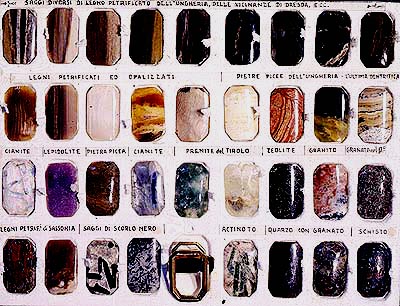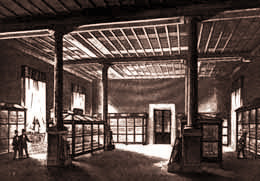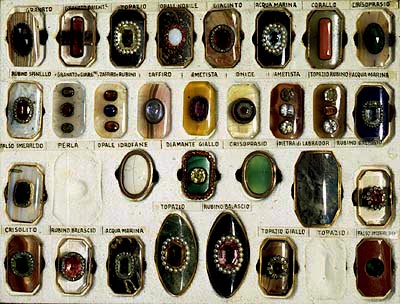
MUSEO di MINERALOGIA UNIVERSITÀ di ROMA "La Sapienza"
Piazzale Aldo Moro 5, 00185 Roma, Italia
Pope PiusVII

The Museum of Mineralogy, University of Rome "La Sapienza " was founded on November 13, 1804 by Pope Pius Vll with breve "Uberes dum menti Nostrae.." and was inaugurated in 1806 in its first building the Sapienza palace, by the architect Gian Lorenzo Bernini, which was then a university building and now houses the State Archives.
The first curator was Father Carlo Giuseppe Gismondi (1762-1824), from the "Congregazione dei Chierici Regolari delle Pie Scuole della Madre di Dio" a distinguished mineralogist, as we can see by the honor conferred on him by K.C.R. von Leohard when he named after him a new mineralogical species, the zeolite gismondite from Capo di Bove near Rome (1817).
The collection entrusted to Gismondi had been started under previous Popes, but most of it had been acquired by Pius VII through the purchase of the collection of Camillo Clerici, a naturalist from Verona (1116 mineral and 88 rock specimens from Europe and India).
The official inauguration of the collection took place on October 27, 1806 with the participation of Pope Pius VII himself, who visited the Museum and, according to the chronicles of the time, spent about two hours there. To mark this event, a cust sculpture of Pius VII and a memorial stone were placed in the Museum; both of them are now installed at the entrance of the present Museum gallery. For that occasion Gismondi also wrote the first catalogue of the Museum Catalogo Sistematico e Ragionato della Collezione Mineralogica appartenente all'Archiginnasio della Sapienza.
Father Gismondi was followed in 1824 by Pietro Carpi, who was instrumental in obtaining to important acquisition: the Dactyliotheca, a donation of Pope Leo XII and the private collection belonging to the pontifical prefect at the time, Monsignor Lavinio de' Medici Spada (1801-1863), donated by Pope Pius IX..
However, the real "father of the Museum" was the mineralogist Giovanni Strüver (1842-1915) a former assistant of the famous mineralogist and stateman Quintino Sella. Stuver discovered sellaite and gastaldite. His name was given to strüverite by a distinguished student of his, Ferruccio Zambonini. During his time at the Museum, Strüver managed to acquire a further 10.000 samples, which were the result of collecting expeditions in Latium, on the island of Elba and in the Piedmont Alps, and of exchanges and shrewd acquisitions. When he died at least 896 mineral species out of the 900 that were known at the time, were represented in the Museum collections. along with almost all the Italian meteorites.
In 1935, Federico Millosevich (1875-1942) senator of the Italian Kingdom moved the Museum to its present location, a building in La Sapienza University Campus which was built by the rationalist architect Piacentini.
Since then, the various Museum's directors (Ettore Onorato, Carlo Lauro, Annibale Mottana, Giorgio Graziani e Odino Grubessi) has continued the task of increasing the collections, especially with regard to the mineralogy of the Italian regions, while carrying out the essential systematic research. This scientific activity is documented by many publications on the material from both old and new collections and the discovery and description of many new mineralogical species: onoratoite, cesanite, sacrofanite, potassio-fluor-richterite, chiavennite, medaite, tiragalloite, vigezzite, peprossiite-(Ce), vicanite-(Ce) which have enriched what was already an important collection of new mineralogical types.
THREE IMPORTANT POPES
Gregorio Luigi Barnaba Chiaromonti (Cesena 1742 - Roma 1823). Benedictine, bishop of Tivoli, was made Cardinal in 1766 and became Pope in 1800.
He agreed to travel to Paris to perform personally Napoleon's consecration as Emperor in 1804. Soon after, Napoleon began to disregard the terms of the agreement, and Pius VII suffered many offenses and impositions, culminating in 1808 in the occupation of Rome by the French troops, the annexation of part of the Vatican State by the Kingdom of Italy and his exile in Savona. Pius VII returned to Rome in 1814 after the Congress of Vienna reinstated the temporal power of the Popes.
This gentle and courageous Pontiff encouraged the arts and the sciences, and was very important for the history of the Museum which was established in 1804 with his breve Uberes dum menti Nostrae...
Pius VII died in 1823, and was succeeded by Leo XII.
Ad futuram rei memoriam
Uberes dum menti Nostrae, fructus occurrunt, quibus eò ditatur magishumana Respublica, quò hominum ingeniis major, ampliorque patet Literarum palestra; nihil sane ducimns omittendum quidquid ad extendenda, augendaque Artium, atque Disciplinarum studia conferre posse conspicimus. Quum itaque rerum naturalium varia suppellex, cui in Archigymnasio Sapientiae Almae Urbis Nostrae omnifariam coagmentanda pluribus ab hinc annis tum a Nostris Praedecessoribus, tum a Nobis etiam ipsis jugis est adhibita cura, adeo jam in i Musaeum excreverit, ut quemamodum nuper exponi Nobis fecerunt dilecti Filii Collegium Advocatorum Consistorialium, nil desiderari aliud videatur, quam peritus, ac idoneus Vir, qui custodiam Musaei hujusmodi peculiarem suscipiat, et de Mineralogia studiosam Juventutem publicé erudiat ;orentque ipsi Advocati, ac humiliter flagitent hac in re per Nos provideri opportunè, atque ut infra indulgeri: Nos ad Arghigymnasii decus, Scientiarumque augmentum Exponentium votis libenter obsecundantes, ipsosque omnes, ac quemcumque ipsorum a quibusvis excommunicationis, suspensionis, et interdicti, aliisque Ecclesiasticis sententiis, censuris, et poenis a jure, vel ab homine quavis occasione, vel causa latis, si quibus quomodolibet innodati existunt, ad effectum, praesentium dumtaxat consequendum, harum serie absolventes, et absolutos fore censentes, hujusmodi supplicationibus inclinati, auditis prius dilectis Filiis Magistro Alexandro Lante Camerae Nostrae Apostolicae Thesaurario, et Archigymnasii praedicti moderno Rectore, auctoritate Apostolica tenore praesentium Cathedram Mineralogiae et Historiae Naturalis eodem in Archigymnasio erigimus, et constitimus, et in Cathedra hjusce Lectorem publicum dilectum Filium Carolum Josephum Gismondi Congregationis Clericorum Regularium Matris Dei Scholarum Piarum nuncupat expresse professum, et luculenter tam ob ejus scientiam, atque peritiam in rebus naturalibus, quam ob ejus idoneitatem, ac zelum in rectè edocendis Juvenibus apud Nos commendatum, pro hac prima vice nominamus, et facimus, eique annuum scutorum centum, et viginti stipendium statuimus, et assignamus, necnon omnes, ac singulos honores, praerogativas, gratias, et indulta, jam aliis Archigymnasii Lectoribus concessa, ac per eosdem quomodolibet gauderi solita concedimus, atque tribuimus, onusque simul diligenter custodiendi praememoratum Musaeum, seduloque incumbendi Lectionibus, quas publicè de Mineralogia, et Historia naturali habiturus in Archigymnasio erit per totum annum scholasticum, ac illa praecipue dierum hora, quam ei Advocatorum praedictorum Collegium designaverit, imponimus, ac strictè injungimus. Decernentes easdem praesentes Litteras firmas, validas, et efficaces existere, et fore, suosque plenarios, et integros effectus sortiri, et obtinere, ac iis omnibus, ad quos spectat, ac spectabit pro tempore, plenissìmè suffragari, ac ab omnibus inviolabiliter observari; sicque in premissis per quoscumque Judices ordinarios, et Delegatos etc. non obstantibus Constitutionibus etc. Volumus tamen, ac declaramus expressè, quod Lector Cathedrae hujusmodi nil umquam in iis, quae ad augmentum stipendiorum juxta praestitutas in Archigymnasio regulas obtineri consuetum attinent, commune habeat cum aliis Lectoribus; sed in recensita sui stipendii summa centum, ac viginti scutorum semper manere, semperque de ea solum contentus esse debeat; Quodque Lecturam ejus praedictae Cathedrae si, et quando in posterum vacare contingat, tunc quoad novum eligendum Lectorem adamussim servetur in omnibus, et per omnia fel. rec. Benedicti XIV Praedecessoris Nostri Constitutio, quae incipit "Inter conspicuos Ordines".
Datum Romae de specialì Mandato Nostro sub Annulo Piscatoris die XIII
Novembris MDCCCIV Pontificatus Nostri Anno V.
Pro D. Cardinali Braschio de Honestis. G. Bernius Substitutus. In Arch Colles. Advoc. Consist.
To future memory of this event
Pius VII institutes the Museum and Mineralogy Chair
An abstract from the breve Uberes dum menti Nostrae...
Plentiful are the fruits...which enrich the human consortium and our knowledge...Therefore we shall not omit anything which may be useful to promote the study of the Arts and Sciences.
Since the wide selection of natural objects collected in the Archigymnasium of the Sapienza school in our City has been increasing to the point of becoming a Museum...and since now on a expert seems to be needed to take a care of said Museum and to instruct publicly the students of Mineralogy,...We willingly agree with those who wish to help the study to Science....We now institute, before the witnesses summoned here, the Chair of Mineralogy and Natural History, to which we appoint, and nominate public Lecturer, our beloved soon Carlo Giuseppe Gismondi of the Congregations of Regular Clerics... He is recommended to us by his learning, his knowledge of natural science as well as his attitude and zeal in teaching. We assign him a yearly stipend of 120 scudi and at the same time we attribute him the same honors and prerogatives already awarded to the lecturers of the Archigymnasium. At the same time we order him to take here diligently of the Museum and to dedicate himself to the public lectures on Mineralogy and Natural History according to the calendar and timing established by the Collegium...
We wish an order that the Lecturer of this Chair should not share the rules applicable to the other Lecturers to obtain increase of their stipends. Therefore the stipend of this Lecturer shall always remain one hundred and twenty scudi...
Rome, for Our special mandate under Piscatory Seal, on November 13, 1804, 5th year of Our Pontificate.
Annibale Sermattei della Genga (Ancona 1760 - Rome 1829), was ordained priest in 1783; later he became bishop of Tiro and apostolic envoy in Lucerne, Cologne and Munich. He was made cardinal in 1816 and Vicar of Rome in 1820, and was elected Pope in 1823.A stern, strict and hard-working person, Leo XII reorganized the educational system under ecclesiastic control and started a wide cultural program through "Ubi Primum" Enciclycal. He also removed Galileo Galilei's works from Index of forbidden books..
Leo XII was interested in scientific studies and particularly in Mineralogy. On November 5, 1824, he inaugurated the Academic Year of the Rome University and visited its Museums, including the Mineralogical Museum, which had been reorganized for the occasion. In February 1825, with a special "Chirograph" document, he authorized the increase of the Museums collections both with financial appropriations and with donations of specimens and other items. (Archivio di Stato di Roma, 1825 b).
Giovanni Maria Mastai Ferretti (Senigallia 1792 - Roma 1878). was ordained priest in 1819, he later became archbishop of Spoleto, bishop of Imola, and was elected Pope in 1846 after the death of Gregory XVI.
The reign of Pius IX, the longest in history (32 years) marks the end of the temporal power of the papacy, the establishment of two new dogmas (immaculate conception and papal infallibility) and the celebration of an ecumenical council. His pontificate started with the hope of a reconciliation between the Catholic church and liberalism, but quickly evolved toward total opposition to modern political ideas and firm alliance to absolutism.
Pius IX must be remembered in the History of the Museum for his purchase and donation of the famous mineral collection of his Prefect Lavinio de' Medici Spada.
Lavinio de' Medici Spada (Macerata, 1801 - Florence, 1864) was a papal official, a poet and a naturalist. In his youth he authored various poetry works and was in friendly terms with several of the most prominent literati of hit time, among them Vincenzo Monti, Perticari and Giacomo Leopardi. He attended the University of Pisa and, after graduation and a short residence in Florence, he enrolled in the Ecclesiastical Academy of Rome. As a non-ordained prelate, he was papal legate in Ravenna, then in Spoleto, and finally in Rome. There he held various positions and was made Prefect to the Arms under Pope Gregory XVI, title he kept also under Pope Pius IX.
After retirement , he dedicated himself to the study of science, partly with the guidance of Humphrey Davy, who was his guest in Ravenna, and in contact with many great scientists of his time. His love for natural history included a specific interest in mineralogy and mineral collecting.
In 1835 Spada discovered the new mineral parisite, a fluor-carbonate of calcium and rare earths, in specimens sent to him by J.J. Paris, proprietor of the emerald mines of Muzo, Columbia. Spada also described a meteorite from the Monte Milone, Marche, Italy, 1846 fall. In 1843 Franz von Kobell named in his honour spadaite, a magnesium silicate mineral from Capo di Bove near Rome.
A gentleman of means, helped by his important position in the Vatican State and by a wide network of international contacts in politic and scientific circles, between 1838 and 1847 Spada was able to assemble an important mineral collection, which included 12228 specimens, many of them rare and beautiful minerals from all over the world. The Spada collection was purchased in 1851 by Pius IX for the price of 20.000 scudi or 100.000 lire, and was donated to the Museum to form the core of its mineral collection.
The Dactyliotheca is a collection of 388 precious and ornamental stones often mounted on plates of agate or other semiprecious materials, mostly cut in octagonal shape, , 28x28x2 to 40x20x3 mm, or as cabochons, about 20x15x4 mm. This plates can be interchanged on two rings, also included in the collection, The gemstones, of different cut and shape, are frequently outlined by minute gems mounted on the same support plates; other plates bear gem compositions portraying various type of insects.
The stones are arranged in 12 trays, subdivided in to three sections of four trays each accordion to their shape and type. The trays can be placed either in a fine tabled-shaped wooden cabinet (about 90x90 cm) or in three book-like cases, bound in red morocco, with the inscription Lang's Museum Mineralogicum (Rome University Inventory No 402).
This collection, donated in 1824 by Pope Leo XII to the Mineralogical Laboratory of the Archigymnasium of the University of Rome, was probably made in Idar-Oberstein at the turn of 18th century.
Two catalogues related to Dactyliotheca have been found. The oldest written in late 18th or earl 19th century hand, is in French and includes 277 stones of the Collection, often with information on their origin (Archivio di Stato di Roma, Archivio dell'Università di Roma, Busta 309). The second document, handwritten in italian, is entitled Catalogo di una collezione di gemme ed altre pietre dure, donate al Gabinetto Mineralogico della Sapienza da Papa Leone XII, and is parte of a general inventory on 25 collections of the Museum, compiled by curator Carpi, and dated October 27, 1843 (Archivio di Stato di Roma, Archivio dell'Università di Roma, Busta 309). This catalogue lists 388 stones, the same number as the present count of the collection, the trays, the cabinet and the cases were all made to host 388 stones. Therefore the French catalogue, which included only 277 stones, was written in earlier times, and later, but before the gift to the museum, 111 items was added.
Accidents and replacements took place during the years, and reports concerning thefts manumissions of rings and gems are on record (Archivio di Stato di Roma, 1861a).
Each sample was numbered progressively and identified by referring to the two existing "Catalogues" .
On the basis of their cut and shape, samples were divided into three Sections, each formed by four plateaus:

Section 1
Comprises 95 samples.
Gems of different cut and shape (32), composite insects (9),and plates showing a mixed cut with an octagonal shape (54), placed on four plateaus with 32, 19, 19 and 25 gems respectively.

Section 2
Comprises 141 samples and a collet.
Plates of ornamental stones showing a mixed cut with an octagonal shape, placed on four plateaus with 36, 35, 35 and 35 stones respectively.

Section 3
Comprises 150 samples and a collet.
Cabochons cut with an oval shape, ornamental stones, placed on four plateaus with 38, 37, 38 and 37 stones respectively.
Often the plates are both a rest for gems of different cut and shape (frequently outlined by minute gems) and for gem compositions portraying insects.
Plate sizes are almost the same, about max. 40x20x3 mm, and min. 28x18x2 mm. The cabochons are also cut to similar sizes, about 20x 1 5x4 mm.
I campioni attualmente esposti nella sala generale, entro vetrine suggestivamente illuminate, sono una selezione dei più importanti minerali dei giacimenti classici italiani.
L' Isola d'Elba con i minerali delle pegmatiti e l'ematite; la Sicilia con zolfo, celestina, aragonite ed hauerite; la Sardegna con fosgenite, covellina e anglesite verde.
I minerali vulcanici del Lazio e del Vesuvio; alcuni esempi di minerali alpini; i famosi quarzi "diamante" dei marmi di Carrara ed una ricca collezione di meteoriti in cui spicca quella di Uegit (Somalia) di 252 kg.
Completano l’esposizione campioni storici e moderni dei più importanti giacimenti europei e mondiali.
Il Museo di Mineralogia appartiene giuridicamente all’Università di "La Sapienza" e afferisce al Dipartimento di Scienze della Terra.
La superficie totale del museo è di circa 1300 mq dei quali 1000 per sale espositive e 300 per deposito, aule e laboratori.
Per la ricerca scientifica il Museo si avvale della strumentazione e del supporto logistico del Dipartimento di Scienze della Terra.
La superficie espositiva attualmente aperta al pubblico (700 mq) è completamente illuminata e dotata di attrezzature informatiche per il supporto multimediale.